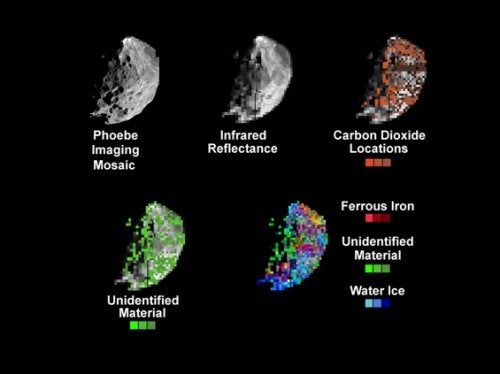Phoebe has always been a little strange. The small saturnian moon, discovered in 1898, has a chaotic, retrograde orbit that takes it far from its home planet. Scientists have long suspected it was a captured object, something that wandered by and was snagged by the gas giant’s gravity.
New data from the Cassini-Huygens spacecraft’s flyby of the moon on June 11 may have solved the mystery. Data from the Visual and Infrared Mapping Spectrometer (VIMS) indicate that Phoebe is a primordial mixture of ice, rock, and carbon compounds. These objects, also known as icy planetesimals, were the building blocks of the outer solar system 4.5 billion years ago. Most of them went into the cores of the gas giants, but some remain in the Kuiper Belt, a region of comet-like debris that orbits beyond Neptune.
Scientists believe Phoebe was swept into Saturn’s orbit as the planet was forming and has been there ever since.
Spectral measurements of the moon confirmed the presence of water ice and detected carbon dioxide and solid hydrocarbons similar to those found in primitive meteorites. There are also chemical similarities between materials on Phoebe and those found in comets.
Cassini scientists also were able to determine Phoebe’s density, which is 1.6 grams per cubic centimeter — lighter than most rocks, but heavier than pure ice. This suggests Phoebe’s composition is similar to that of Pluto and its moon, Charon, which are also thought to be Kuiper Belt objects.
The average daytime temperature on Phoebe is about —261° F (—163° C), and even colder nighttime temperatures suggest its surface is covered with a few millimeters of loose dust and ice particles.
The Composite InfraRed Spectrometer (CIRS) mapped Phoebe’s surface, showing that “Phoebe is a very complex object, with large variations in topography,” says John Pearl, a CIRS co-investigator. “Phoebe has been badly chewed up, probably by meteorite impacts.”
“We have conducted our first analysis of an outer solar system resident akin to Kuiper Belt objects,” says Dennis Matson, Cassini’s project scientist. “In two short weeks, we have added more to what we know about Phoebe than we had learned about it since it was discovered 100 years ago.”










